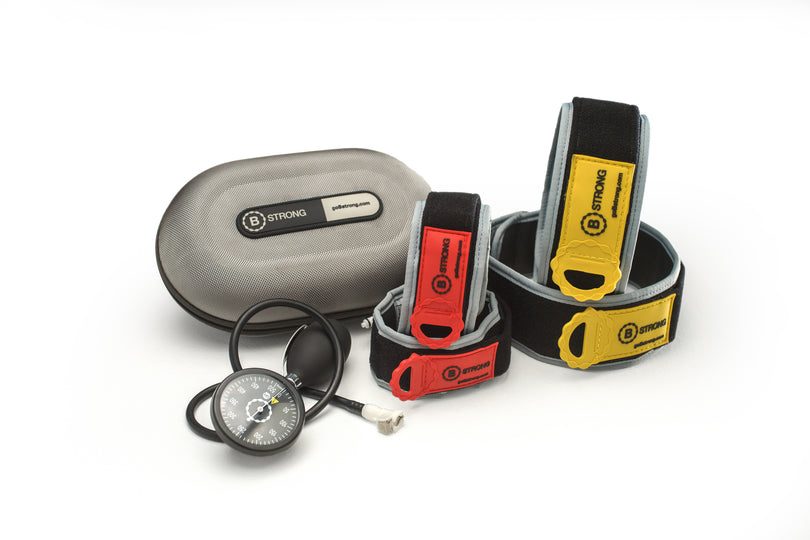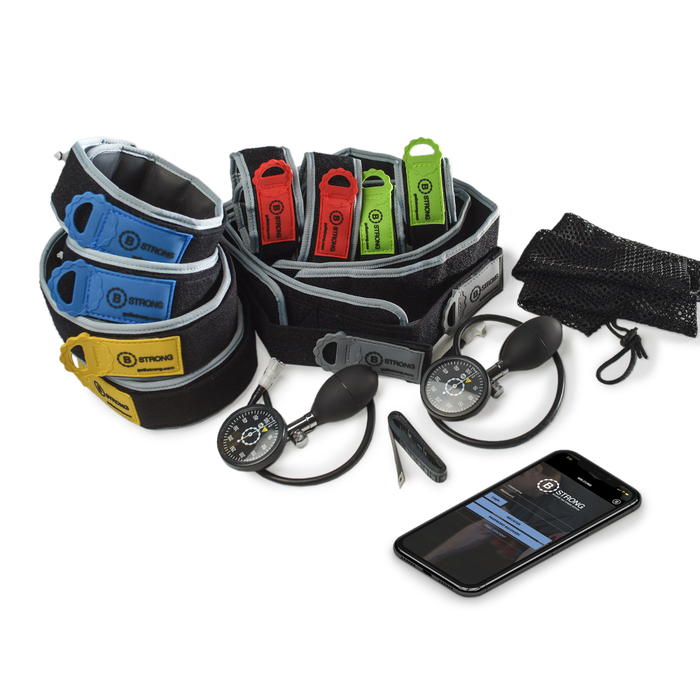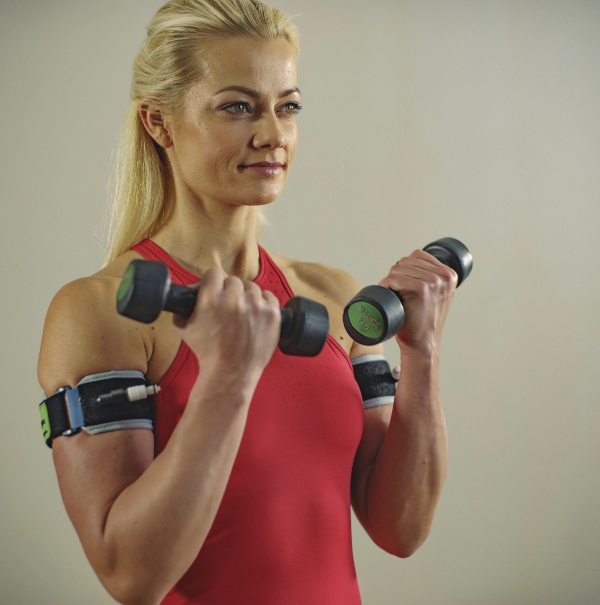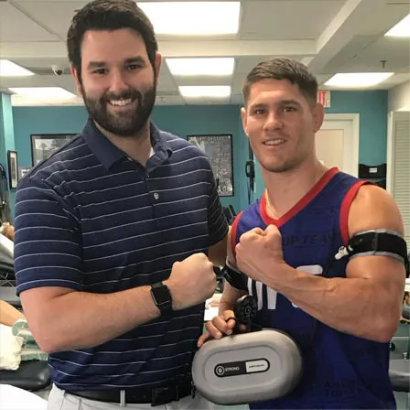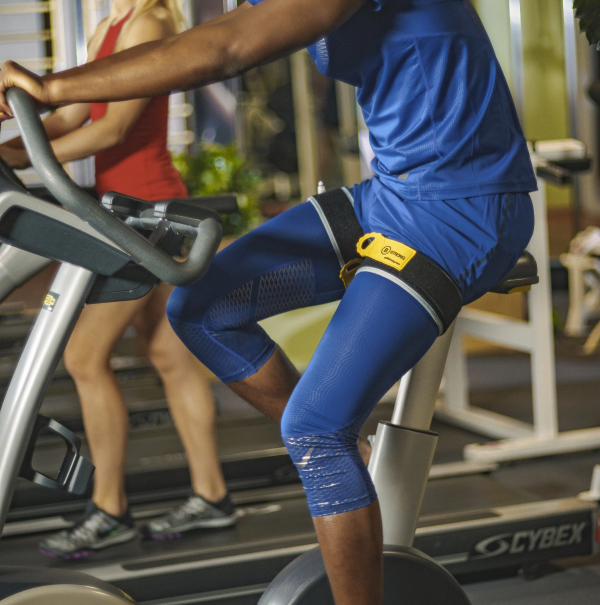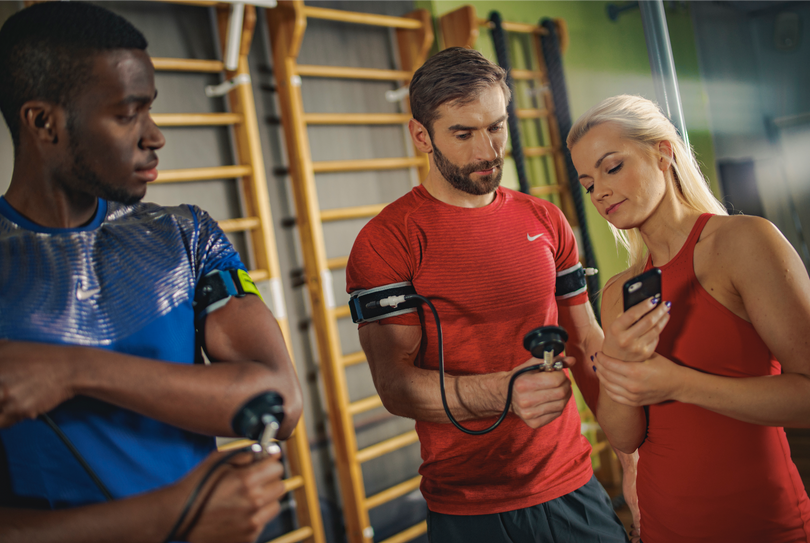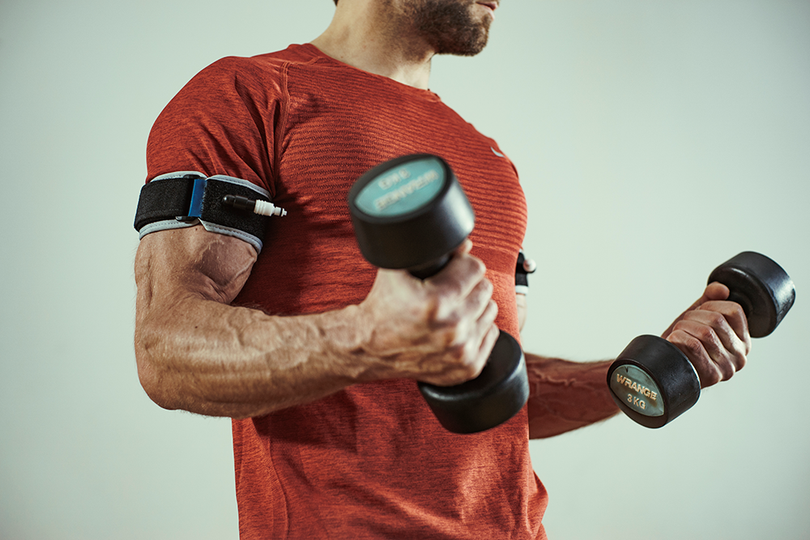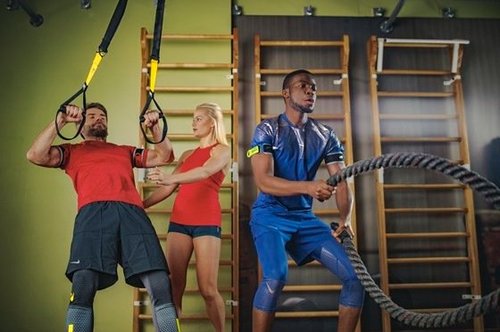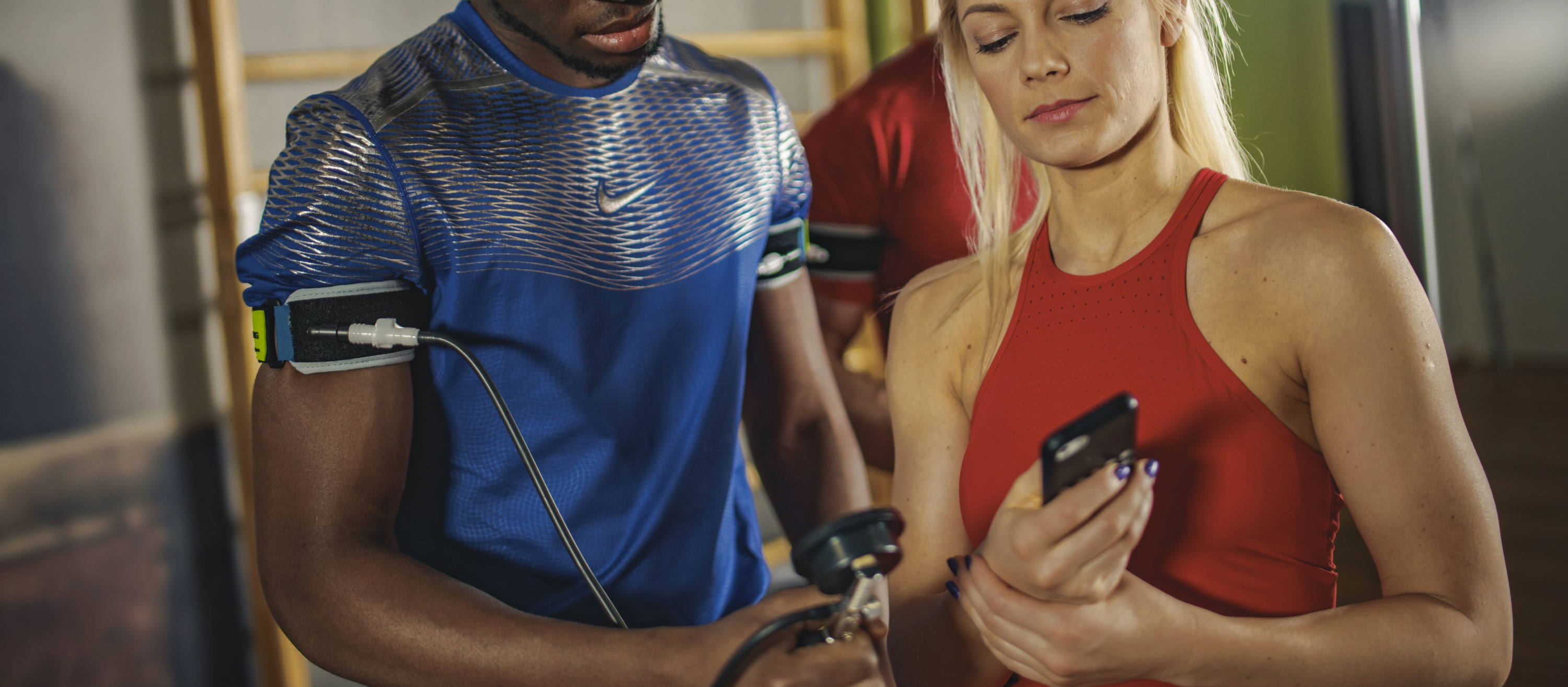SOURCE: Decoding SuperHuman - Boomer Anderson
Tackling misinformation, live high / train low, blood doping, and blood flow restriction training with a world-renowned physiologist and physician and pioneer in sports medicine.
Dr. Jim Stray-Gundersen shared his wealth of expertise is a diverse array of athletic performance fields.
Who is Dr. James Stray-Gundersen?
Jim Stray-Gundersen is a world-renowned expert in Sports Medicine, Exercise Physiology and Training for Sport Performance, and is a world-renowned expert in BFR Training. Drawing from his lifetime of experience with elite level athletes and clinical populations, Dr. Jim Stray-Gundersen is one of the world’s leading physiologists and strongly believes that BFR will revolutionize training and rehabilitation everywhere.
In designing the B Strong System with Sean Whalen, Dr. Stray-Gundersen wished to make the most affordable, simple, safe, and effective BFR training bands on the market so that he could share this discovery with as many people as possible and increase the overall fitness of the world. Dr. Stray-Gundersen has identified the key mechanisms, applications, and safety guidelines and applied them to develop a safe and effective product.
He also lectures throughout Europe and North America for those seeking protocols and guidelines to maximize benefits and eliminate risk of BFR training.
As a physician, Dr. James Stray-Gundersen has treated thousands of patients and athletes alike. As a researcher, he authored the ground-breaking study, “Live high, train low” that revolutionized altitude training. As a sports scientist, he has worked with elite-level teams in skiing, cycling, running, soccer, and countless others
Dr Stray-Gundersen has been involved in the training regimens of Olympians and World Class athletes resulting in over 100 Olympic Medals and World Championships. With over 40 years of hands-on experience with people and athletes of all ages, Dr. Stray-Gundersen has constantly been at the forefront of top-level performance. He predicts, B Strong Training will change how the world gains the benefits of exercise, improving longevity and quality of life. B Strong Training will change your life.
Highlights
[7:43] Speed Skating at a High Level
[9:56] Blood Doping and Developing WADA
[18:01] Benefits from Living High, Training Low scenario
[24:42] Discovering Blood Flow Restriction Training
[31:24] Effective workouts with Blood Flow Restriction
[41:04] Blood flow Restriction training and recovery from ailments
[43:21] The B Strong Innovation
Episode Transcript
Boomer Anderson: [00:00:00]Welcome to decoding superhuman. This show is a deep dive into obsessions with health performance, and how to elevate the human experience. I explore the latest tools, science and technology with experts in various fields of human optimization. This is your host Boomer Anderson. Enjoy the journey.
If you check. This episode out on my YouTube channel. You'll know, I notice that my tongue is blue now. Why is my tongue blue? Well, I'm taking a nootropic or Smurf Tropic. If you will called blue canteen, it helps me with verbal fluency, short term memory focus and keeping up with guys like Dr. James Stray Gundersen.
It has four ingredients, nicotine. Hemp crystals, caffeine and methylene blue, which deliver this amazing Limitless, like experience for four to six hours. And there's no calm down like some other nootropics. So if you want to try this head on over to troscriptions.com, use the code BOOMER for10% off and let me know Limitless ride feels.
Let's get on with my conversation with Dr. James Stray Gundersen. Today's conversation actually began with a text message or originated with a text message. Dasha Maximov sent me a message and said, Hey, you need to try this because it is right up your alley. Short-cutting anabolic responses and exercise.
Yes, of course. It's right up my alley. And a few minutes later, I was emailing back and forth with my guest today. Dr. James Stray Gundersen. And if you're familiar with that name, you may have heard of live high train low for which he was the coauthor on that paper. But dr. Stray Gundersen is a world renowned expert in sports medicine, exercise, physiology, and training.
Frankly, if I were to read his entire resume, it would take up an entire podcast episode. But drawing from his lifetime of experience with elite level athletes in clinical populations. Dr. Jim stray Gundersen is one of the world's leading exercise physiologists who strongly believes that blood flow restriction will revolutionize training and rehabilitation everywhere and designing the be strong system was Sean Whalen.
Dr. Stray Gundersen wished to make the move affordable, simple, safe, and effective blood flow restriction training brand on the market. And he wanted to share this with as many people as possible today, we had a wide ranging conversation from the origins in the Midwest to his time, spent in Europe with Olympic teams, such as the Dutch speed skaters, but also the Norwegian Olympic teams.
And we got into blood doping. What that meant his study of hypoxia and how that led to his real interest in blood flow restriction training. By the end, we wrap up with the be strong training device and why it is one of the most revolutionary fitness devices on the market today. If you want to check out this episode, well, you're checking out this episode, but if you want to check out the show notes, head on over todecodingsuperhuman.com/drjim and enjoy my conversation with a sports. Legend Dr. James Stray Gundersen. Alright, Today's review is called cutting edge.Right? Thank the person who left this. I left the review for five-star same for anyone interested in how they can be better. This is the podcast for you.Boomer dives into difficult issues and decodes, the controversies and myths.
If you believe human optimization is possible. And if you didn't, you wouldn't be listening to the show. You really need to listen to the show. So thank you to the gentleman who left that show. And if it grabs you in a good way, head on over to iTunes or Apple podcasts, as it's now known and leave a five star review because.
I'll read that on the show and also it helps get the word out. Thank you,
dr. Jim, welcome to the show.
Dr. James Stray-Gundersen: [00:04:41]Thank you, boomers. Nice to be here.
Boomer Anderson: [00:04:43]When we were chatting beforehand, aside from getting to meet your entire dog family, we're talking a little bit about the, your experience with theNetherlands speed skating team. And I would love to just understand a little bit more from, you know, What brought you to being involved with theNetherlands speed skating team?
Dr. James Stray-Gundersen: [00:05:01]And what was that like for you? I would say it's more correct that, I've been involved in, the international Federation for, speed skating, which is ISU. AndI I've been, at one time I was, on the medical committee for ISU and.Responsible for putting in our blood testing program or hematologic passport.
in addition to that, I've worked, closely with the American, the Canadian and the Norwegian, national speed skating teams, both long track and short track. And, in that way, I've. Ended up spending a lot of time atHeron vein, for example, and a lot of other ice rinks around Europe and, also gotten to know many of the, Dutch coaches and skaters and doctors and that sort of thing.
most recently, I was pulled into a case for a yarrow, Yvonne Kirkoff who's, she's a, short track racer and, she got falsely involved in a little bit of trouble with her hematologic passport. And I was, happy to be able to get her out of that.
Boomer Anderson: [00:06:13]In terms of chemo, a lot, the humans passport, just for those who are not aware of that, is that some I'm guessing something to do with the blood testing experience.
Right.
Dr. James Stray-Gundersen: [00:06:22]Yeah. basically in the late eighties into the nineties, very are actually earlier than that, but let's just go with that. blood doping became a problem in many sports, including Speed skating cross country skiing, track cycling, pretty much anything where you needed sustained activity for more, more than two or three minutes.
And. I ended up being part of a group that, came up with a testing plan to deter and detect blood doping practices in short, in short there's, you can either get transfusions of your own blood or someone else's, or you can take, these, hormones or drugs, like, EPO that, Get you to make your own red blood cells.
And, so, I was really the medical expert in charge of that with, ISU. And if you're dealing with ISU, you're dealing with Dutch speed skating.
Boomer Anderson: [00:07:25]Before we go down that anti-doping route. What brought you to speed skating in general? Because I know you've been in the field for a while.
Dr. James Stray-Gundersen: [00:07:36]Yeah, you're, you're Dutch.
Your audience will like this. I, I grew up in Wisconsin, close.
Boomer Anderson: [00:07:43]I went to university of Minnesota, so we have a little bit of a big 10 rivalry here.
Dr. James Stray-Gundersen: [00:07:47]Okay. Yeah. Well, I went to, I went to Madison, so, ah, okay. But anyway, I grew up outside of Milwaukee and, near where the, Why are the, one of the few ovals is in the United States or was it that time?
And, my dad who, immigrated from Norway, had a parable speed skates that he used to use. So, we would end up, going out and trying that just a little bit for fun. we of course followed everything in the various Olympic game when all of the games as they were coming up. And, and then when I was inMadison, actually, I would go out on to the lakes and just to skate around and,Eric Heiden and his sister and his mother were out there training.
So I hopped in with that. And so this was when I think Eric was 12. So this must have been 1970. Two or so. And, anyway, since that time have had a, a hand in us speed skating, as well as that evolved into a, this anti-doping effort and then being a, expert for various kinds of training, again for, the U S Canadian and Norwegian teams primarily.
but you had some interaction with the Dutch.
Boomer Anderson: [00:09:11]Did you at one time live in Norway as well?
Dr. James Stray-Gundersen: [00:09:14]Yeah. from 1996 to 2002, we, lived, outset just on the edge of Oslow. I know it's great. very much enjoyed that time. I was, I was a professor at the sport college there and, I also worked for the Norwegian Olympic committee.
Horrible.
Boomer Anderson: [00:09:31]Very cool. So I want to go back to that anti-doping situation, because you mentioned earlier that doping has been an issue in sports for a very long time.And what sort of, I guess, was this something that it was a personal passion of yours in terms of discovering, these people that were doing it?
also, you know, how did you begin to dig into that stuff?Cause I believe the initial one was in Finland, right?
Dr. James Stray-Gundersen: [00:09:59]Yeah, well, the first testing thing. Yes. the, I growing up in Wisconsin, we did a lot of winter sports. Yeah. as I, I got to be pretty close to a national level and in a variety of these things.
and then, and then having gone to med school and all that, I ended up, being part of these teams more of as a physician, a physiologists, as opposed to, one of the athletes, but, In that, in those roles, I saw that we were getting beat by people who were doing some pretty strange things. And, you know, you kinda have a couple of choices, none of us like to lose tan.
So, either we had to join them or somehow arranged to, deter their use and, Obviously the ethical choice is to try to deter their use. And so, that was really what started the, the thing at the time, there was no blood testing and sport and, there's no way to. catch blood dopers without testing blood, a manner or another.
So, that was the first big political, but yeah. and. At the time at the time, I was mainly involved with cross country ski racing. And so from the, and in, so instead of ISU as a Federation for skating, I was dealing with FIS or the international ski Federation. And, we were the first to put in any kind of blood tests, for a health check.
At in, in our world cup. but you know that in a way that was somewhat of a victory. And, we first did that in 1989 and, at the Lottie Nordic world championships and, Basically, we ran some tests to, check the people's hemoglobin concentration as well as, we tested, the blood for EPO and we, tested what's called a partial glute nation reaction, which tests for the use of someone else's blood and, And we didn't catch anybody or at least of the people that we, we sample, they were all normal.
but, it was a bit of a victory because it was the first time in international sports where we were able to take blood samples and. It kind of seems like maybe it seems a little silly now, but, in my first efforts to get testing put in, I was told, Oh, you know, it's way too invasive to draw blood on somebody and you know, what are we going to do with all that medical waste?
And, you know, and it's just a lot nonsensical. another one was, you know, it was against someone's religion to have blood drawn. and anyway, there is 1,000,001 excuses why we couldn't do this. And it was actually a, a good political victory to be able to, to sample blood. And, you know, what's, what's behind all this stuff, is that when you're in the middle of these kinds of things, petitions, by the time you're at an Olympic level or an international level, everybody's a good athlete and everybody skilled and.
And there's a set of rules that people agree to play by. And it was pretty clear to me that, there were particularly certain groups that weren't playing by the rules and, that wanted to do what we could to, have them play fairly as, as well as the, in re in. And that would then improve. My athlete's abilities to be successful.
Cause they really didn't have a chance otherwise
Boomer Anderson: [00:14:10]and if you don't mind, and I'm curious what your thoughts are on the current state of doping in sports, because I'm sure you get asked this question all the time. Like, has it been reduced or people getting, if you're willing to, yeah.People are getting smarter about it.
People are getting more innovative when it comes to these processes.
Dr. James Stray-Gundersen: [00:14:32]I, in general, I think things are much, much better than they, than they were in the eighties and nineties. there still are ways to beat the system and you find those on occasion. the other yeah. Aspect of this is that. one of the, one of the things that the hematologic passport kind of does is it it's not designed to catch athletes doping it's designed to, characterize and identify when big changes happen and then say, well, why is what's going on with this change?
And in it, and in a way it's like a, one of the auditorsMADEC traffic camera boxes, where, you know, everybody's speeding like crazy a mile or a kilometer before that, but they slowed down for the box. And so it it's really like putting a speed limit. Thanks. And, yeah. And then, so what happens because these are in, this is indirect doping.
And so what happens is if you wildly dope or, you know, transfused yourself with five units of blood or whatever, it's going to show upon this as a huge change. Now, if you, you know, transfuse a quarter of a unit of blood, hematologic passport may not even register that this is something different. So one of the nice things about the hematologic passport is that, it, it kinda confines the athletes that want to cheat into more normal behavior.
That they can get away with and not get caught. And so before you know, it, they're kind of not cheating very much and not getting very much of an advantage so that, clean athletes can compete with them. Cause one of the big things that, I saw a lot is clean athletes coming in fourth or fifth.
Not winning their metal, but you know, if they were, if the truth be known, they were actually the best athlete out there. And the fittest athlete out there on that day. And, it's a real travesty, both financially and fame and everything else where they don't, they don't receive that recognition.So that was a driving part to it.
And so we, we, we think of. Rather than kind of good cops and bad ass or whatever. we, we want to essentially it's, it's not like we're trying to say, okay, you were doping it's we're trying to say, okay, everybody's got to more or less plan on a safe and even playing field. we'll see, to carrying that out.
So that, you know, there's an even competition.
Boomer Anderson: [00:17:40]One of the things my audience may not be aware of is that you originally coauthored the paper on live high train low, and I was. We'd love to just explore the potential benefits of this for, for instance, a cognitive athlete, like could there potentially be benefits for cognitive athlete in a living high training, low scenario.
And what would those be?
Dr. James Stray-Gundersen: [00:18:04]The short answer is yes. so when, when people, when people go first go to altitude, it starts in a climatization process. and that the climatization process, the strangely enough, when someone goes to altitude, their problem is not getting as much oxygen as they needed to.
And you need oxygen to think and to do pretty much anything.And, So adaptations are put into place to try to, mitigate, the lack of oxygen that, that may be there. And, we know from, some Russian studies in, in theHimalayas. Where, Russian soldiers would have to go up into Pakistan and India and various places on the POL where they're at very high altitudes, their cognitive function would deteriorate such that they were not operational and.
But that if they would spend two to three, three to four weeks there, then all of a sudden these things would come back. So whatever adaptations they got from that altitude exposure, help them with their cognitive function, certainly add altitude and, you know, you probably had the same thing coming back for awhile.
Boomer Anderson: [00:19:25]So I live in the Netherlands and this is a selfish question, which, you know exactly. Let's see. Yeah. What we're below, right? The joke is, is that God built the world in seven days. And then the eighth day, the Dutch built another ones. Right. And so, you know, I have almost the. The exact opposite situation that I would want.
And in terms of mimicking this live high train low for a cognitive, my life has predominantly cognitive athletics, if you will. But I do still train like an athlete. Is there any way to mimic that? Like, are any of these devices worth it?
Dr. James Stray-Gundersen: [00:20:05]Well, there are nitrogen tents that, were actually first invented in, in a vascular, Finland, by a friend of mine named Hakey Risco.
And, the idea is that Finland and the Netherlands don't have mountains high enough to. Come and visit park city. So yeah, which I've been there and I love going there, but it's not exactly the shortest flight in the world. No, but you know, there's a direct flight from salt Lake to Amsterdam.
Boomer Anderson: [00:20:37]I've been on that flight a couple of times actually.
Dr. James Stray-Gundersen: [00:20:40]anyhow, the, the, idea is that you can create these little micro environments that simulate altitude and, we know they work for increasing, red cell mass and, and they can induce the ventilatory changes. We see with altitude exposure. I don't know that anybody's really done a lot of cognitive testing before and after in between, see what's going on, but.
There are ways of simulating altitude at Cielo.
Boomer Anderson: [00:21:12]It, if you were to design your own experiment here, w what would be kind of the amount of time you'd want to spend in one of these nitrogen tents, if you will, to try and simulate this and perhaps do that cognitive test.
Dr. James Stray-Gundersen: [00:21:27]Yeah. So. Imagine a spectrum, creating hypoxia, from putting a plastic bag over your head, pretty small volume, but be effective if it's sealed right.
And all the way to living in the mountains where everything, things hypoxic. So somewhere in that spectrum is the situation that works for the individual, depending on where they happen to be. And, Then the next overlay is okay if I, I, and generally, if you're creating any situations, you want to live there for a substantial length of time.
So, you know, if you're going to convert your bedroom to a nitrogen room, for example, you know, the intention is to be there for months and, and. Yeah. One has to balance the volume of space. You're making hypoxic with the psychological cost of being cooped up into something. So we've all felt that recently, right?
Yeah. Right, right. Exactly. And so, so here in park city where I get outside and you know, everything's fine. That's very nice psychological. Situation where if I had to be confined to a room, I mean, that isn't so nice. And, and if that, if that in that room, it was, you had to spend12 out of 24 hours. Maybe it gets doable, but then one of the things that's on the market are basically little camping tents that you can do this with.
And or things that you just put over your bed and thats pending significant time in there, has its psychological costs. Let's put it that way. And so, you know, you have to figure out what's right for you with, with all this stuff. Okay.
Boomer Anderson: [00:23:32]And then once you come down from altitude, is there a particular length of time that. Before you just adapt and go back to quote unquote normal for that.
Dr. James Stray-Gundersen: [00:23:43]So different adaptations come and go at different rates. So generally it takes about four weeks to have a significant increase in red cell mass. And you have that significant increase or a benefit for about four weeks after. You believe, the vanilla Tory adaptations that happen.
they usually come within a week and they're usually gone within a week come down. So I'm there lots of little small things that.Probably can't be studied. one of the things that's a common observation for whatever reason is that people that have spent time at altitude, adapt really quickly when they come back to altitude again.
And then whether that's, they've kind of learned how to behave or, there's some residual adaptations, Who knows? Maybe both.
Boomer Anderson: [00:24:39]So where does blood flow restriction training come into this entire picture?Because you've had this massive career and performance sports at one point, did you discover this?
Dr. James Stray-Gundersen: [00:24:55]specifically I became aware of, the original Japanese version KATU, back in,2000. Oh, probably 11, but it wasn't so much of that. So I would say a common thread throughout my career has been the use of hypoxia a one way or another.In the case of blood doping, obviously increasing red cell mass is a way of delivering more oxygen to the tissues that need it.
And Al training is about being hypoxic and having the proper adaptations happen there. A thing about blood flow restriction training, it's another way of inducing local hypoxia in the tissues while leaving set the brain and the heart, the rest of the organs to get the normal oxygenated, blood. And so, so.
It, it ends up being a very interesting tool to start separating kind of the systemic from the local effects of hypoxia and from, and that's what the attraction is from a scientific standpoint.
Boomer Anderson: [00:26:06]And you've spent time in Japan studying this, I believe. Right, right. And so,I guess, you know, looking at just. The wide range of benefits in terms of, blood flow restriction training. Before we get into that, just kind of, if you don't mind explaining to people exactly what the, what is blood flow restriction training and you know, why, why we should be interested in yeah.
Dr. James Stray-Gundersen: [00:26:38]Great questions. The short answer is that it's anti-aging medicine.
Boomer Anderson: [00:26:44]Okay. That's something that's going to light up a few people that are listening to this by the way.
Dr. James Stray-Gundersen: [00:26:48]Right. And, and it should, cause this is really, the cat's Meow in terms of, us, us optimizing our health span in our lifespan, but let me sort of get in, cause it it's actually. there's two things.
One is science as not fully understand stood how the body adapts to exercise stimuli and some recent things. And. I actually work over the last 20 or 30 years, at, at my institution in Dallas, at a UT Southwestern, provided a background to really understanding some of, some of these things.What, what produced, what, and, And, you know, so we all kind of have this image in our head.
If you want to get good at something physical, you ought togo do that thing, and then you get better. And, that is kind of the standard approach with weight training, where let's say you want to get strong biceps, you ended up doing bicep curls. And the idea is that you're training that bicep muscle and its tendons and everything else to be able to do more work.
it turns out that, and we've all heard from our training backgrounds or at least American football players have about no pain, no gain.And, you know,
Boomer Anderson: [00:28:18]had that drilled in my head growing up.
Dr. James Stray-Gundersen: [00:28:21]Okay. There you go. And the thing is, that's not right. . But in some ways it is. Yeah. If you start flipping things around, so.
we're not talking about pain, but the way that the body head apts to physical stress, is it sensing what's going on in those tissues, from sensory nerves and those sensory nerves, take information back to the brain that something is happening. And usually if you're, exercising hard or long or that sort of thing, The, the tissues that are working, send a signal to the brain.
That's saying, Hey guys, this isn't a lot of fun here. We bet we ought to stop at mile 20 or, you know, let's, let's put that 300 pound weight down and, That fatigue signal ends up. Not only letting the organism know that they're fatiguing, but it is also the initiation of the processes that will then rebuild the tissue and, and take it, take it even farther.
So, so what happens is. And the body does this with a lot of different things. There's sometimes the signal is an alarm signal, but it's also a stimulus to produce, the solution for whatever the problem might've been. And, so what be strong training does and BFR training in general is supposed to do, is it.
Bio hacks or, sends, sends a signal to the brain to adapt with that. Having done the long or intense exercise it takes to send that signal normally. So you don't have to be out at mile 20 on your marathon. you could in, and you were saying in 15, 20 minutes, you can get a full workout and profound feelings of fatigue.
It was. From a combination of light, otherwise easy exercise plus, restricting or not letting the working tissue get all the blood and oxygen, they need to sustain the work. So that combination has created a, whatI call it, disturbance of homeostasis in the working tissue. And there's various biochemical things that are associated with that.
But suffice it to say that that disturbance of homeostasis.Number one is sensed by the brain, but also in itself starts local a upregulation of protein synthesis and a lot of other things trying to repair the damage it thought was being done. The trick is we really didn't do any damage.Yeah. And so you started to adapting and getting better, right?
From the get go. And in as few as three to five to seven workouts, you can notice significant improvement in strength and ability to do things.
Boomer Anderson: [00:31:24]And so you kind of hit a, a very strong buzzword with this audience, which is15 to 20 minutes and wow. I can get a complete workout and it seems extremely effective.
Now there's a few things that I would love to just kind of follow on and double click here. on those various, mechanisms that actually caused this to work. You, you touched on one with kind of protein synthesis, but what are some of the other things does that happen within the muscle that.Because we're not tearing muscle here necessarily if I understand that.
Right. What other things are going on that cause people, cause when I came across blood flow restriction training, it was that bodybuilding crew that was really using it to get quote unquote squall. but what are some of the things that are going on that helped build that muscle in such a short time?
By the end of this episode, you may get really, really excited about be strong. You may get really excited about blood flow restriction training. You may wonder where can I check this thing out? Head onover to be strong.training and use the code boomer for 10% off. Because I'veused it for the past month and I absolutely love it.
And you guys will, too. It fits in my suitcase. It goes with me everywhere. And I use it every day as we're going to discuss here in a little bit, and I don't have the need to have rest days, which is amazing for habitability. Enjoy the rest of my conversation with dr. James stray to understand.
Dr. James Stray-Gundersen: [00:33:07]Yeah. So essentially we're tipping the balance between build up of tissue and breakdown of tissue. And, so we're kind of optimizing thing. Not only does the disturbance of homeostasis. And for example, those things include a drop in pH or the ass. The amount of acid increases in a cell, the GoTo, or they might have oxygen goes down in that cell.
very, and, shortly the cell starts to run out of ATP or intracellular, phosphates, really the energy currency of the cell. And, When you get low levels of intracellular, phosphate, then electrolyte, gradients don't work. Right. And all, all sorts of things, you start going outside of these ranges of parameters where things can work.
Right. And, that in and of itself is a stimulus to protein.10th is in the cell to try to fix these problems. in addition, it also starts a process where we increase the number of, anabolic hormone cell receptor, on the surface of the, of the shell. So that any anabolic hormones or anything else that are coming along.
Are more likely to bind to that cell and more likely to amplify, the anabolic processes that are going on. And so one of the things that, what we do now is that a, yeah, to work or the study was done with katsu is that. 15 to 20 minutes after a decent katsu workout, you increase, growth hormone, production from your brain and growth hormone in turn stimulates the liver to make more, IGF one or insulin growth factor one.
in addition, it stimulates the testes to produce more testosterone. all of these things, if you will, there's an anabolic or building mill you that has created that amplifies, anything that was going on now, in addition to that, one of the things that we do with blood flow restriction training is we modify, we basically distend the veins and the capillaries and, and not much happens to the arteries under the right circumstance, but, We end up when we do exercise, imagine we have this extremity that's full of blood, cause it's kinda gotten backed up and then you do a muscle contraction and that muscle squeezes this blood out and puts it back into the central circulation.
Hmm. And so what you have with capillaries and veins is you have well, this distension and emptying of these walls and that actually.Causes a series of things to build new and better blood vessels or new and better endothelium. And, that's a big part of the anti aging thing. So when we're built and, this has been done, there's a paper by a guy named Larkin that was in medicine, science, sports, and exercise.
I believe in 2014. 2015. Anyway, he looked at, increases in mr. And a, or the initial building block for a particular kind of protein, specifically for VGF, hip one, alpha nitric oxide, synthetase, iso forms, and all, all these things are critical components to building new and better people vessels.
And he found that these things. We're at sometimes tenfold, stimulated, by blood flow restriction training compared to normal training alone or the same kind of work. So, We know that we have very powerful or we have data that says we have very powerful stimuli to, increase size and strength of muscle to, decreased fat mass or to mobilize fat stores and decrease fat stores.
And to build new and butter, better blood vessels. There's also information that we can improve bone density, as well as improve the tensile strength of tendons and ligaments. There's even a rat study that showed that, A version of blood flow restriction training in a rat where they tie off the femoral artery.
Boomer Anderson: [00:37:36]I was going to ask how that actually works with our app, but, it, it ends upcutting down.
Dr. James Stray-Gundersen: [00:37:42]It doesn't cut all it restricts blood flow into the extremity. And, the rats can't run anymore, but they can, they can, walk around just fine, cause of the collateral circulation. So, but yeah, what they were looking at in this study is they found that, the density of, nerve receptors on muscle membranes, as well as the number of, synaptic vesicles.
On neuro fibers was increased. these are called nicotinicacetylcholine. Receptors. And the way that nerves transmit is that there's these little vesicles in the nerve ending that release acetylcholine into the space between the nerve and the muscle surface, and acetylcholine goes and binds to these nicotinic acetylcholine receptors.
And in that way, propagates the bio electric, for, for country that's about to happen. And, and they did this study in aging rats. And what we know that happens with aging, it's kind of on this, lose it, or if you don't use it, you'll lose it idea is that the density of these kinds of, of, nerve receptors, was decreased with age and humans and then everything else.
And they found a way in a rat to stimulate, increasing. The density of these things, the idea being that if you have more. or a higher density of these nerve receptors, you're more coordinated. you can get more contractile, efforts going and everything else. So nerves, bone, tendons, ligaments, muscles, blood vessels, pretty much everything in there.
Extremity fat, all of these things show adaptations that are associated with essentially anti-aging. So it's very, very nice story, actually. And I would say the crux is, and you know, you point to this 15 to 20minutes, the crux is we found a way all of these adaptations happen. With athletics, but you have to be doing, you know, a hundred mile weeks or, you know, doing things that by the time you get three, my age, it just can't do anymore.
And, so this in a very time efficient manner. Recreates the really good things that happened when you were able to do 10 hours or 20 hours of training in a week. And for those of us that have jobs and families, and don't have two to three hours a day to spend in the gym. Yeah, exactly. So be strong as a solution to getting that kind of good.
A regular exercise. It stimulates adaptation, to produce a good, healthy lifespan.
Boomer Anderson: [00:40:42]Wondering if you're willing to just hypothesize or just think through this, if there hasn't been any studies, because some of the therapeutic effects, you mentioned things like improvements in vascularity, bone density, et cetera, have direct implications for some pretty large problems within society.
Has there been any studies with effects of this on things like cardiovascular disease? Obviously I think osteopenia is a given. Orosteoporosis, but those types of diseases. Yeah.
Dr. James Stray-Gundersen: [00:41:12]Some, they, they use, cuts for, cardiac rehab in Japan. So, and they, feel that it's better than normal exercise, partially because it's not as hard and partially because you can get a better.
Probation of the system with blood flow restriction training than you can normally. the other thing to say is that, and this is more of aNorth American problem than a European or Japanese problem, but we there's, there's something called metabolic syndrome or metabolic, which is being overweight.
Having a high cholesterol, having a high blood pressure and having, high blood sugar or diabetes. And this is a constellation of things that come from basically no regular exercise and a typical American diet. And, or I should say a relatively high fat, high protein, low carbohydrate diet that, no.
Ends up using a lot in the products. That's a whole nother story. Another episode with you, dr. Jack there. but, there's preliminary data that a be strong training, program, mitigates all of these factors that reduces body fat. It reduces blood pressure. It reduces, or improves glucose control and improves lipid profile.
So, but show does normal regular exercise if you do enough of it. And again, we get back to this thing of, we've. Maybe stumbled upon a method for, or everybody to get in the regular exercise. There's a need in a very convenient way, whether it's at home at work on the road, a hotel room, and a very short period of time to get the benefits they need from regular exercise to have a healthy lifestyle.
Boomer Anderson: [00:43:21]As well we haven't yet, but you made some innovations on blood flow restriction training. Do you mind just discussing how the be strong, device differs from, anything from just like putting wraps around your arm to other
Dr. James Stray-Gundersen: [00:43:37]So, so that's, you know, that's. It's kind of funny. That's where a lot of this stuff started.
basically taking a judo belt and wrapping around and extremity multiple times kind of cranking it down and, that's associated with problems and there's, there's a lot of guys in the gym who are. Taken Cub scout belts and everything else, and kind of cranking them on and saying, Oh, I'm doing blood flow restriction training and it's not really effective and it's not really safe to do it that way.
And so one of the first big innovations that, Sato made washe, he, he, he actually used a bicycle inner tube. You know, where, he used that to inflate and by inflating that to a certain amount or a certain pressure, he could get to a reproducible amount of blood flow restriction each time from person to person and from within the same person from one time to another, where none of these infections.
Previously, systems that did really have a capability of being inflated were a bladder. you know, it was kind of all over the place.You, you, you got it right one day and you didn't get it right the next day.And, so that happened for a while. And then, actually a bunch of people in theWest started seeing.
What katsu was doing. And I thought they knew what the device was. So they went out, ran out and I hold blood pressure cuffs, which we have that inflatable thing. but, blood pressure cuffs differ from the strong and katsu in that, once you put the blood pressure cuff on. The, the, the vaultI am inside the cylinder that's contained by that company.
I can't change. So it's, it would what I refer to as a rigid system. Yeah. And then what happens is when you blow in or fleet of bladder within a rigid system, you know, something's got to give somewhere. And, what happens is you collapse the veins because they're a pretty low pressure system.And so you collapse the veins and then by the time you get over, arterial blood pressure, you occluded the, the arteries as well.
but beyond that, there's not much else it can leave this cylinder or this contained by this, by this rigid outer cuff. And so when you exercise, muscles swell, just normal. And, also as you're, as you're doing a contraction, the muscle is shortening and it, but it's getting fatter. So now a sudden you're taking up more space in a cylinder under that is contained.
And, and one of the things that Sato did in one way, we did in another way, which is to make it a habit elasticity to this outer. Outer circuit. And that really, creates a safe and very effective way of doing blood flow restriction training. So, you know, too, two big things, one the inflatable aspect so that you could control how much pressure was going on.
And then. Secondly, the elastic aspect, to accommodate muscle contraction and muscle swelling as it goes, and to only really, restrict the venous outflow and still allow arterial inflow, which is, is key to safety.So, And, none of the other systems do that except for katsu and be strong. And, we do them in different ways where when you inflate, when you inflate our device, it actually the whole band kind of contracts and helps you with the blood flow restriction.
where, when you inflate a katsu device, it expands and stretches and got all the ministries. yeah, that's kind of the big difference between us, but, the kind of, so what of that is that it turns out that, we're much better. The way that we have this design, there's, there's a limited amount of contraction that can happen.
And that's small enough so that no matter how high you run the pressure, really, you're not going to get any more, because of the volume in the sun. Yeah. And we've done it in a way where it all it. It ensures, the arterial end flow into a, into an extremity is maintained, which is a really big deal.
It sounds a little weird, but it's, it's a really big deal for making a safe system. Yeah.
Boomer Anderson: [00:48:36]Can I just double click on that for a second? Because if I'm hearing that correctly, you guys have a web app, which explains how to set this up and sort of the ideal pressures for the individual. if I read what you said correctly or heard, cause I'm not reading right now. if. Can I over pump the system and therefore create this situation of occlusion or is that impossible to do.
Dr. James Stray-Gundersen: [00:49:04]You know, you never want to say anything's impossible, but normal circumstances placing the bands in the right place using our pump that has a limited 500millimeter 500 millimeters of mercury.
you, you can pump, you can, our recommendations typically for arms, or it might be from 200 to two 50, but you can go to 500 and still have, have, the Arturo land. So they'll maintain. So, we ended up, you know, these absolute statements are they're dangerous. I know, but, if the bands are put in the proper locations and our pumps are, our pump is used and our recommendations follow, it's virtually impossible to occlude our tree line flow.
Boomer Anderson: [00:49:51]Because the muscle isn't necessarily tearing. Can I use it every day?
Dr. James Stray-Gundersen: [00:49:57]Yeah. So I'm one of the big things. That a lot of the power sport athletes found there was bodybuilding or, or a weightlifting, or for example, eightAlpine skiing. And in my case that were very involved with, they normally would have have 48 hours between a really hard, intense workouts.
Again, as some muscle was damaged in the, of course of the, of the workout. With, with be strong. Instead of every other day, you can do two workouts today, if you want it to amen. Recover quicker from, and if you're getting, if you're getting, let's say four times the, the impulse or the stimulus move forward, you're going to end up with that.
Yeah. Yeah. Adapt quicker. And particularly if you haven't done any of the damage in the first place, so, and then another factor is, is kind of age. And as we age, we're less tolerant of hard work. And so what I would say is that, athletes who are used to training in their twenties and thirties, they might do to be strong sessions a day.
Kind of recreational or everyday folk between, I dunno, 40and 60. Maybe they, they do, five days a week or maybe it's, they end up finding out that three is as much as they really feel good about handling. And it, it has to take into consideration all the other things that are going on in their lives.
And, but it's kinda nice to get into a. A weekday routine of first thing in the morning, you do 15 to 20 minutes and you're off, you know, just like you brush your teeth and you're, and you're off a good, a good path.I would say that the elderly, you know, eighties, you know, elderly is getting older as, as I am, but, people in their eighties ended up kinda drifting in to about twice a week as what's right for them.
Boomer Anderson: [00:52:05]So yeah, the, the two sessions a day. you know, which is by the way, how you outlined it in terms of waking up. And basically instead of brushing my teeth,I put on the be strong. I do brush my teeth, eventually brush your teeth too.One more. I'm glad we have the zoom because then you can smell my breath.
I'm I'm joking. but. In terms of other exercise, because there is a lot of people listening to this, myself included that have this sort of Puritan work ethic and feel like they have this need to run, swim, jump all of this stuff. Yeah. Is anything else fundamentally needed or is that just sort of added bonus afterwards?
Dr. James Stray-Gundersen: [00:52:50]well they're there there's. I think there's lots of reasons to exercise. One of the reasons to go cycling or they're jogging or playing tennis or soccer slash football or whatever, is cause it's fun. And yeah. then another, their component of this is usually maybe not so much when we're young or, but as we age, we need to be doing fitness activities so that we can enjoy.
These they're, they're certainly exercise activities, but they're the, the basis for them is fun and, and health for that, for that matter. And, the lifestyle that I would. Recommend creating is one in which, you know, you kind of get the chores over with in the morning. First thing is include a be strong session.
15 minutes is good enough on a daily basis. And, And then go about the rest of your day. And if, if that day called for a tent, 10 kilometer jog, great, our a hundred kilometer bike ride, great. you know, whatever, whatever the rest of your other, otherwise your life was about.
Boomer Anderson: [00:54:05]So what's the significance of the lightweight. Like, because, you know, I did do power lifting for quite a long time. And there is that inner egoic thing that, you know, you want to pick up something heavy, but with this, you know, it's high reps, low weight. What's the significance of this
Dr. James Stray-Gundersen: [00:54:24]thing we're going to do with you boomers. We're going to paint your way pink.
Boomer Anderson: [00:54:28]And, and I am painting. I am painting quite the image of myself and I know this is the first time we met, but, I'm totally fine with big weights. Let's do it now.
Dr. James Stray-Gundersen: [00:54:39]So, so the I here and here, here's what a lot of weightlifters and body buildersthat have gotten into this do is they may test themselves with normal lifting workouts once a week, or once every 10 days and more or less as a test to see how they're doing.
And. Yes. They've been doing be strong, all of a sudden it, their max reps or, or their max, their one rep max is going up and they're just piddling around with dinky little things. And generally we use for, for those people that are lifting. we say that anywhere from 20 to 30% of one rep max is my weight, which for anybody that's really lifted her, are you kidding me?
That's ridiculous. I'm not going to get stronger doing that, but that's really the key here because. What we're doing normally, when you're doing heavy lifting, maximal lifting, you have to recruit pretty much the whole muscle to get to move the weight or whatever muscles are involved in the lift.And, With be strong.
What happens is we're just recruiting the easiest, recruited fibers and we're getting them because they're not, and they're usually the most dependent on blood flow, but we've restricted that blood flow. So they get into metabolic trouble and they get to a point where they can't maintain it. Yes.
Yes. The. The guy in the, in the brain is saying, I want you to continue doing that. They have to use other fibers to get, get that done.And so before you know it, you start recruiting all the fibers in the muscle.And as you get deeper and deeper into fast Twitch populations, they are less and less back vascularized and get into metabolic trouble quicker than they usually the most thing.
And so you end up creating this, disturbance of homeostasis and this cascade that goes through the entire motor unit. And, that's the way that you end up, stimulating adaptation and even even the fastest, which fibers. And we, we, we know this because, cause there've been muscle biopsy studies that look at, you know, one measure of, the use of a fiber is that, it's, it's become glycogen depleted from, the work it's done.
And we, we can see that with elastic BFR training, we candeplete all the fibers in a particular, muscle. So we know we're getting into those, faster Twitch populations and stimulus those fibers that you can either do with a heavy, heavy lift. Or you can do with a combination of both weight lift and blood flow restriction and yeah.
Producing that, stimulus for adaptation and. One of the things is, and I'm sure you can relate to this. This is, you know, let's say you're doing some heavy squad or something and you're saying, Oh well, can I, you know, I add another, you know, 10 kilos onto the bar or not. And then maybe you get into the weight and you get through one rep and you go, yeah, I don't know if I'm going to be able to do that second rep or whatever with blood flow restriction training.
You mean maybe doing squats with just the bar. And, and.Really getting fatigued and, and, but it's, you're able to take that risk of doing that last or that last two reps, because it's no big deal. If you drop the bar where if you lose control of, you know, 200 kilos over your head, that ends up being a problem.
And so you can actually press yourself into a greater degree of fatigue with, with, blood flow restriction training than, than otherwise.And if you do happen to lose control the weight, you're not going to hurt your back or drop it on your foot or your throat or whatever.
Boomer Anderson: [00:58:51]My my L four L five.
Thanks. You already, there you go. In terms of it, just one last question, before we go into just some final, rapid fire questions, the effects of this, are they systemic or should I be doing training splits of kind of upper lower? how do you look at them? Huh?
Dr. James Stray-Gundersen: [00:59:08]My short answer is both. Okay. There are definitely local effects and to get specific adaptation for, let's say specific lists, you're going to want to do those lifts.
but they're the big key to this thing is the systemic effect of inducing this anabolic, hormonal cascade. So both.
Boomer Anderson: [00:59:33]Thank you for all of this, dr. Jim, and just a huge debt of gratitude before I get to those questions, because this device I've enjoyed it. It's I like changing workouts from time to time, but like, there's something about the B Strong one.
I could throw it in my carry on. Which is extremely important to me. and I don't need much in terms of accessories with it. You mentioned the pink dumbbells, if you will. but you know, bands, whatever it isI can use and you don't need much and you can do it everywhere. I've done it on zoom videos.
Dr. James Stray-Gundersen: [01:00:08]You can get a, you can get a workout in and the time it would normally take you to get to the health club.
Boomer Anderson: [01:00:14]Yeah, it's crazy. And. No, I haven't done the two-a-days yet, but you've seeded the idea with me. So I'm probably going to do that very soon. So thank you for this.
Dr. James Stray-Gundersen: [01:00:25]You can also get on that bike behind you.
Boomer Anderson: [01:00:27]I probably haven't done that again. Another great idea. So I'll let you knowhow that goes. Maybe I'll post a video on that one too. Okay. Final, rapid fire questions for you. What sites you about, or what excites you most about the health world right now?
Dr. James Stray-Gundersen: [01:00:50]okay. So, okay. The deal used to be, some line came along and bit you in the leg and you sought out the doctor to try to fix the damage that the lion did, or you were skiing and you. Hurt your knee or whatever. And so this, or you developed a fever and you got sick, so then you sought out medical help to deal with a specific, health issue and that, and that's evolved into heart attacks and all sorts of other things that, that in my mind are, labeled disease care and,What I'm excited about is that we're, the world is transitioning into something that I would call health care, although it's a little bit different definition and that basically is.
Is, prudent and responsible nutrition as well as regular exercise in various forms and then can throw in not smoking and not riding motorcycles and, don't do drugs and those sorts of things. Maybe sleeping a little bit. Yeah. So, and, and so it, we're starting to. Transition into what we should all be about, which is maximizing our health span
while still dealing with the occasional, pandemic that comes along or, or, heart attacks or that kind of thing, from, a, institution, or I don't know what you want to call it. That's been focused on dealing with problems. As opposed to what amounts to preventative medicine or, that sort of thing.
And I think. I think be strong has a very big place in being able to deliver that a daily dose of, exercise is medicine for, for the population for pretty much everybody. And particularly for those, those people whose lifestyles end up, making them press for time to, to get that stuff done
Boomer Anderson: [01:03:12]book, which has most impacted your life.
I'm sorry, what? The book, which has most impacted your life. Wow. Oh,
Dr. James Stray-Gundersen: [01:03:28]Oh, there's much. You can go with more than one too. Yeah. I think, books that impacted by there. I ran into these while I was in med school and in my residency. but things like death, be not proud, by Kubler Ross. there's another book. That's the title is, forgive and remember, which is about, And, you know, the old, the expression is forgiven forget, but, here we want to forgive and remember, and, and, and it's, and it's about, physicians in a medical center and, and what they have to do with the various things that they run into.
Another set of books that I really liked a lot, was, done byCarlos Castaneda about, it's about a, basically, Southwestern and Mexican, shamanism and ways to achieve spiritual, reflection, that, that I think have served me well. couple of other philosophers, I don't know. I don't read a lot in the novels. The things I read are generally scientific papers and I don't know that they move me terribly. what's your top trick for enhancing your focus? If you have one? I dunno, just, trying to try to lead a healthy lifestyle. I would. Yes, Dr. Jim, where can people find out more about you and this fantastic device that you've created? Well, I would direct them to our website, the letter B strong.training. that's, that's pretty much the best place these days to go for things.
Missing, dr. Jim, thank you so much for taking the time today. This has been an absolute pleasure and really big education for me. So thank you again for everything you do and the device you've created. It's fantastic. Well, thank you very much. It's a pleasure to speak with you and.You do it again to all the super humans listening out there have an Epic day.
Okay. There are some episodes that just leave me saying, wow, that's one of them. Dr. Stray Gundersen did not disappoint. And why would we think he would? Because he's done. So much in the world sports. I love the conversation about live high train low and how it applies to the cognitive athlete. I enjoyed learning so much from him about blood flow restriction training so much so that we're going to have another episode on the B Strong device.
Very, very soon. The show notes for this one are decodingsuperhuman.com/dr. Jim, as dr. Jim. And if you enjoyed the episode, share it on the social medias, tell a friend and tag decoding superhuman, because I really appreciate you and want to acknowledge you. Thank you for listening. Have an absolutely Epic day and choose health.
Source
Boomer Anderson
Resources
On Death and Dying by Elisabeth Kübler-Ross
Journey to Ixtlan by Carlos Castaneda

